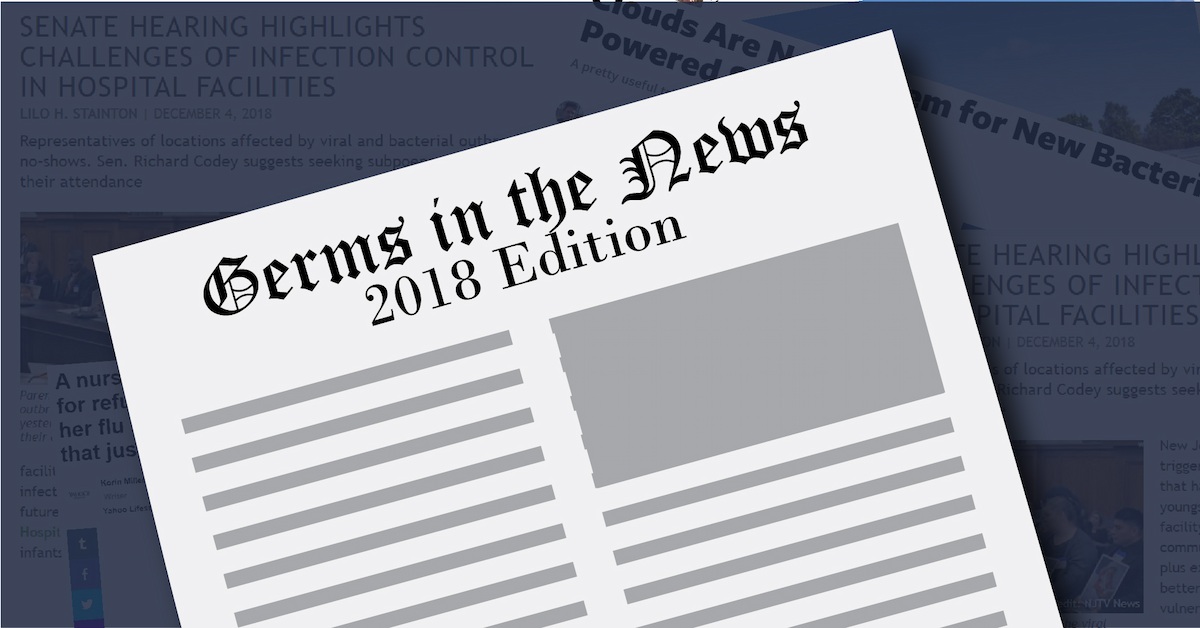 Bacteria and infection made news headlines this year, from outbreaks to breakthroughs. Today's post will explore some of the biggest news stories of the year as we begin to wind down 2018.
Bacteria and infection made news headlines this year, from outbreaks to breakthroughs. Today's post will explore some of the biggest news stories of the year as we begin to wind down 2018.
We'll start with recognizing an important health event from history: The 100 Year Anniversary of the Spanish Flu. This pandemic was responsible for more than 50 million deaths worldwide, peaking in the year 1918. Roughly a third of the entire global population was infected with this strain of influenza (H1N1), which spread quickly due to the extensive troop movements of World War I. Without vaccines or treatment, infected individuals would succumb to the respiratory illness within days. Thankfully, we now have advance notice of influenza, with vaccines created specifically to protect us from the strains detected each year.
We tend to consider pandemics of this kind as things of the past, but this year we were reminded that pathogens can still get the better of us. A strain of acute flaccid myelitis (AFM), a polio-like virus, has infected 158 individuals (90% are children) in 36 states. The outbreak is currently considered in decline, but peaks have been noted every other year since 2014. Another pathogen that made headlines is the increasingly drug-resistant carbapenem-resistant Enterobacteriaceae, or CRE. While the CDC announced in April of this year that results from the Antibiotic Resistance Laboratory Network (ARLN) are promising, this is a pathogen that hospitals continue to monitor.
Some outbreaks, like that of AFM, emerge spontaneously from natural causes. Other outbreaks, like the one that made headlines this past fall, emerge as a result of human error. Within the span of two weeks, to major outbreaks affected the state of New Jersey. The first affected infants in the NICU of Newark University Hospital, while the second affected children who were patients in long-term residential facilities. The NICU outbreak revealed lapses in infection control, such as hand hygiene, while the LTCF outbreaks were linked to poor infection control protocols such as lack of quarantine space. Both outbreaks received significant national news coverage and both resulted in massive interventions to correct the flaws in infection control.
Some outbreaks that could have been prevented have been traced back to a larger-than-recommended population of unvaccinated individuals. In one private school in North Carolina with exceptionally high vaccine exemptions (110 out of 152 were unvaccinated), an outbreak of chicken pox affected 36 children, putting them at significantly greater risk of developing shingles as older adults. This incident is not alone; dozens of similar outbreaks have affected other areas with low vaccination rates. There is still controversy surrounding vaccines and employment in healthcare - several stories covered the issue of employment status and flu shot compliance in various parts of the country. If this years' news is any indication, controversy surrounding vaccines is here to stay.
But not all bacteria news was bad news in 2018! This year, bacteria-powered solar cells allowed collection of power even during overcast days, in a cheap and sustainable form. Researchers also found that typical, regular childhood infections could protect against leukemia - helping a child's immune system to learn how to respond to pathogens without going into overdrive typical of leukemia. And finally, in a story we'll explore in a future post, scientists aboard the International Space Station were able to fully sequence bacteria found aboard the station, taking a first step towards microbiological exploration in space.
As in any year, 2018 brought its share of good news and bad news about pathogens and healthcare. We are grateful to those dedicated researchers on the frontlines of microbiology and epidemiology who help keep us safe, day in, day out - year in, year out!


